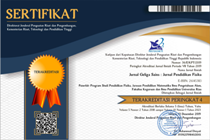High School Students’ Responses to the Magic Number Method as an Alternative for Solving Relativistic Kinetic Energy Problems
Abstract
Relativistic energy is a material that is considered difficult by students because the general solution takes quite a long time. This is based on the results of interviews with students of SMAN Plus Sukowono. The magic number method is a method using the Pythagorean principle through special numbers that are often encountered in relativistic energy problems. The purpose of the research was to obtain data on student responses to the magic number method as an alternative solution to the relativistic kinetic energy problem that makes it easier for students to solve relativistic energy problems. The research method used by the researcher is the survey research method with descriptive analysis. The respondents used were 28 students of class XI MIPA SMAN Plus Sukowono and used an assessment instrument in the form of a response questionnaire. Student response questionnaires were compiled based on Stellen M. Chafe's theory which was based on the cognitive, affective, and conative dimensions. The results of the research on student responses to the magic number method as an alternative solution to the problem of solving relativistic kinetic energy problems obtained percentage data on the cognitive dimension of 72.93% in the positive category, the affective dimension of 80.63% in the very positive category and the cognitive dimension in 75% in the positive category. The average of the overall response dimensions is 76.19% in the positive category. This research can be concluded that the magic number method can be used in physics learning the theory of relativity.
Keywords
Full Text:
PDF (Bahasa Indonesia)References
Arikunto, S. (2010). Prosedur Penelitian Suatu Pendekatan Praktik. Jakarta: Rineka Cipta.
Efendi, D. N., B. Supriadi, B., & Nuraini, L. (2021). Analisis Respon Siswa terhadap Media Animasi Powerpoint Pokok Bahasan Kalor. Jurnal Pembelajaran Fisika, 10(2), 49-53.
Emiliani, E., Zulirfan, Z., Z, F., & Februartati, F. (2018). The Application of Learning with Cognitive Conflict Approach in Improving Understanding Concept of Physics of Class VIII Students of SMP 40 Pekanbaru. Jurnal Geliga Sains: Jurnal Pendidikan Fisika, 6(1), 31. https://doi.org/10.31258/jgs.6.1.31-38
Hadijah, S. (2018). Analisis Respo Siswa dan Guru terhadap Penguunaan Multimedia Interaktif dalam Proses Pembelajaran Matematika. Jurnal Numeracy, 5(2), 176.
Hartini, S. (2019). Revolusi Ilmiah: Global Positioning System (GPS) Sebagai Bukti Empiris Teori Relativitas. Jurnal Filsafat Indonesia, 2(1), 27. https://doi.org/10.23887/jfi.v2i1.17548
Haryadi, R., & Yusifa, A. (2021). Metode Hypnoteaching Terhadap Pembelajaran Fisika. Alpen: Jurnal Pendidikan Dasar, 5(1), 50–61. https://doi.org/10.24929/alpen.v5i1.70
Kartini, K. S. & Putra, I. N. T. A. (2020). Respon Siswa terhadap Pengembangan Media Pembelajaran Interaktif Berbasis Android. Jurnal Pendidikan Kimia Indonesia, 4(1), 12-19.
Khasanah, R. U., Supriadi, B., & Prastowo, S. H. B. (2019). Aplikasi Metode Pythagoras dalam Penyelesaian Soal- Soal Relativitas Khusus Einstein terhadap Hasil Belajar Siswa Kelas XII SMA Negeri Ambulu. 8.
Kurnia, A. (2021). Konsep Pemahaman Teori Relativitas Khusus Einstein Tentang Pemuaian Waktu. 15(2), 7.
Mangei, F. A., Komariyah, L., & Goma E. I. (2021). Respon Siswa Kelas X IPS SMA Negeri 2 Sendawar terhadap Penggunaan Media Pembelajaran Online pada Bidang Studi Geografi. Jurnal Pendidikan Gografi Undiksha. 9(3). 155.
Midroro, J. N., Prastowo, S. H. B., & Nuraini, L. (2021). Analisisi Respon Siswa SMA Plus Al-Azhar Jember terhadap Modul Fisika Digital Berbasis Articulate Storyline 3 Pokok Bahasan Hukum Newton Tentang Gravitasi. Jurnal Pembelajaran Fisika. 10(1), 8-14.
Sambada, D. (2012). Peranan Kreativitas Siswa Terhadap Kemampuan Memecahkan Masalah Fisika dalam Pembelajaran Kontekstual. Jurnal Penelitian Fisika dan Aplikasinya (JPFA), 2(2), 37. https://doi.org/10.26740/jpfa.v2n2.p37-47
Sari, I. D. P. (2021). Respon Siswa Terhadap Pembelajaran Fisika Menggunakan Model Pembelajaran Pbl (Problem Based Learning) Di Sman 2 Tanjung Jabung Timur. 6.
Sari, P., Dwikoranto, D., & Lestari, N. A. (2021). Analisis Respon dan Ketertarikan Peserta Didik Terhadap Pelaksanaan Pembelajaran Fisika Berbasis Environmental Learning di SMA. PENDIPA Journal of Science Education, 5(3), 337–344. https://doi.org/10.33369/pendipa.5.3.337-344
Hastuti, D. A. W., & Wiyanto. (2019). Pengaruh Model Pembelajaran Guided Inquiry dengan Metode Eksperimen Terhadap Keterampilan Proses Siswa. Unnes Physics Education Journal. 8(3), 288-298.
Supriadi, B., Harijanto, A., Widyawati, T., Alisia, N., Arifin, M. M., & Fikri, A. M. K. (2019). Pythagoras Method to complete Einstein Special Relativity Issues. Journal of Physics: Conference Series, 1211, 012050. https://doi.org/10.1088/1742-6596/1211/1/012050
Wati, S., & Hamid, A. (2017). Analisis Hasil Belajar Siswa dalam Menjawab Soal Fisika dengan Menggunakan Strategi Saps Di Mtss Babun Najah Banda Aceh. 5.
DOI: http://dx.doi.org/10.31258/jgs.10.1.8-15
Refbacks
- There are currently no refbacks.
Copyright (c) 2022 Bambang Supriadi, Nila Rayi Puspitasari, Ferdi Ahmad Dani, Annisa Tri Rahmawati, Hikmatul Mukarromah

This work is licensed under a Creative Commons Attribution 4.0 International License.
Jurnal ini terdaftar dan terindeks pada:
- Crossref
- Google Scholar
- Crossref
- Garuda
- Sinta
- Researchgate
- Dimensions
- Base
- Scilit
- OneSearch
- Road
- CiteFactor
- ResearchBib
- WorldCat



















